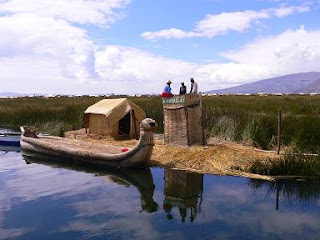Most visitors to Peru focus on exploring the Uros Floating Islands. More than 40 unique floating islands can be found on Lake Titicaca, the highest navigable lake in the world some 12,000 feet above sea level, and also South America’s largest lake. Located in the South eastern part of Peru near the city of Puno, the far side of the lake is bordered by Bolivia.
 |
| Uros Floating Islands - Peru |
These islands are made and inhabited by the Uros people, who settled in the middle of the lake and started their strange lifestyle as a mean to avoid confrontations with the more powerful Collas and Incas. Uros, however, have long been intermarrying with Aymara Indians, so nowadays it would be more precise to refer to the families that inhabit the totora-reed islands as Uro-Aymaras.
 |
| Uros Floating Islands - Peru |
The larger and most visited islands appear to many travellers as floating souvenirs, and to some extent these indeed are tourist-traps, their inhabitants having succeed in living off tourism. However, most of the smaller islands remain isolated from visitors and still practice a traditional way of life that includes old-technique fishing, bird-trapping, and relying on totora for housing and transportation.
Getting to the Floating Islands
Flying into the nearest airport in Juliaca is possible but the more intrepid Peru traveler may choose to explore the country more intensely by flying into Lima and then taking several days and various modes of transportation to truly experience the flavor of the countryside, the people and the culture.
 |
| Uros Floating Islands - Peru |
Following the winding narrow roads of Peru into the mountains and into the small town of Puno, so high above sea level almost touching the clouds, the spectacular expanse of Lake Titicaca that greets visitors rounding the corner coming out of town is postcard perfect. There’s not much to see in Puno so most travelers head straight to the lake to the floating islands nestled amongst the natural islands of Taquile and Amantani. None of the islands, natural or man-made, have any cars or roads, only footpaths and peace and tranquility. The lake is a very spiritual place as it is believed that Manco Capac, the original Inca chieftain, rose from the waters of Lake Titicaca to create the Incan Empire.
 |
| Uros Floating Islands - Peru |
Lake Titicaca's Islands of Reed
The floating islands are made by hand from tortora reeds by the Quechua and Aymara Indians that inhabit the islands and welcome visitors, even for overnight stays so they can experience the simple lifestyle of the natives. The amenities are limited. However, there is the odd hut sporting a satellite dish precariously perched atop its thatched roof alongside the solar panels that power the rare televisions. The same type of reed is also used to make the island dwellers’ homes and boats. Reed boats take travelers from one floating island to the next with a special visit to the largest one where the school house sits.
The Inca Experience
Many visitors wrap up their visit on the lake with lunch on Taquile where the only footpath from the dock leads them on a steep journey through Inca and pre-Inca stone ruins and terraced farms into town where the local children adorn newcomers with friendship bracelets they’ve woven by hand, which are said to bring good luck. Plans should be made in advance since, with enough warning, lunch is typically prepared and served in one of the local’s homes. There are a few very simple restaurants near the central plaza but the home-cooked meal and hospitality is the favored experience.
 |
| Uros Floating Islands - Peru |
Best times to visit are February or November when the Semana de Puno festivities celebrating the Inca culture are in full swing and Peruvian folklore is celebrated.
(Suite 101 and The Peru Guide)

No comments:
Post a Comment